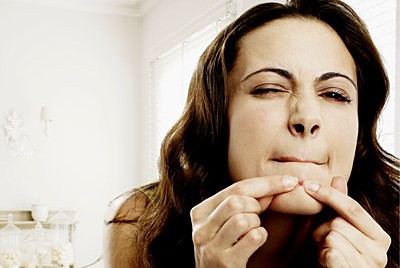Ashley Williams, a holistic health coach, went vegan for the health, ethical, and environmental reasons – but her skin still broke out. Here’s how she got to the bottom of her skin problems, and why (even if you are eating a clean veg diet!) you may still be struggling with cruelty-free induced blemishes!
The other day I had a chat with an entire family of vegans – the first I’d ever met. The first thing they said to me was “so what’s your vegan story?” Had they asked me about being vegetarian, I would’ve had a great story to tell but, to be honest, when I first decided to try veganism it was because I’d heard Alicia Silverstone say that going vegan cured her skin problems. And then to really drive the point home, I read a quote from Woody Harrelson saying that within days of going off dairy – his skin cleared up. I was sold!
I’d had acne since I was a young teenager (and horrible eczema before that). While I was working in the entertainment business, adult acne was just not cool. So on a whim – I decided I’d give up my beloved yogurt and eggs for my skin. Fast forward a few weeks, a few google searches, and this video from Paul McCartney switched me from being a bullshitty vegan to a full-blown ethical vegan. I sold my leather shoes, donated my wool coat and bought vegan Band-Aids (yes, there are vegan band-aids).
But even with my newfound enlightenment and passion for animal rights, I was STILL dealing with crappy skin issues. Had I been sold a bill of goods? Had the Celeb-Vegans tricked me into it??
Turns out that while dairy (inflammation causing) and eggs (histamine producing) are major trigger foods for some people, they weren’t for me. It would take more than a year for me to identify my skin’s nemesis: wheat.
Now I’m able to literally turn on or off my acne with my food choices. If I just really, really need that bagel, sometimes I’ll have it, but only if I don’t have to be anywhere fancy two days later! Because I know that eating wheat and gluten will cause a flare up.
I Went Vegan… Why Does My Skin Still Suck?

For other vegans, the triggers may be some of the other foods we think are safe for us to eat because they aren’t coming from an animal. However there are still lots of foods that create inflammation in the body or trigger the release of histamine. Both of which can cause acne, eczema or rosacea.
Here are some foods that are vegan approved, but are known to cause skin issues:
- Breads, pasta and cereals
- Tofu
- Sugar
- Soy Sauce
- Citrus Fruits
- Strawberries
- Chocolate
- Champagne
- Beer
- Wine
- Corn
- White Potatoes
The best way to identify your triggers? An Elimination Diet.
1) To do an elimination diet on your own, I’d recommend first spend a week observing and tracking what you’re eating. If you have a skin flare up during that time…look back at what you ate 2 or 3 days prior. This can help you narrow down which foods to start eliminating.
2) You’ll want to choose the ingredients you feel may be a trigger and cut one or all of them out completely for at least two weeks (ideally for an entire month or even six weeks). When I say cut it out completely – I mean be super strict about everything you eat. No cheating. Read ingredients. Pretend you have a horrible, life-threatening allergy and if you accidentally get a trace of that ingredient, you’ll end up in the hospital! I’d also recommend adding in a high quality probiotic at this time as well. Help your body rid itself of any traces of leftover foods more quickly.
3) Observe how you’re feeling and what your skin is like during the time you’re avoiding a specific ingredient. Has your acne cleared up? Did your eczema subside? Or should you go to an acne consultant like those at Plumped or a dermatologist for eczema?
4) At the end of your elimination period…try adding back in the ingredient you’d been avoiding (warning: with something like gluten, you’re likely to experience some tummy discomfort). Watch your body’s reaction closely over the next couple of days. If you have a flare up – you’ll know that you’ve identified your trigger food! Keep in mind – you may be affected by more than one food.
Eventually, if you clean up what you’re eating and work on improving your digestion – it’s likely you’ll be able to add back some or all of your trigger foods.
Luckily there are lots of great alternatives for people who eat differently.
My personal go-to for both vegan and gluten free recipes are two cookbooks by Allyson Kramer, Great Gluten-Free Vegan Eats and Great Gluten-Free Vegan Eats From Around the World. Check out her website Manifest Vegan.
A few other sites (beyond GirlieGirlArmy, of course) that I often send my clients to : Elana’s Pantry, Sugar Free Mom, Healthful Pursuits and of course the Meccas of vegan recipes: VegWeb and Finding Vegan.
While identifying how foods effect us can take some time, the long term benefits of being in control of your own health totally make up for it.
Ashley Williams is a holistic healing coach who works with women to heal their chronic health issues. Trained in natural healing and plant-based nutrition, she focuses on making it simpler for her clients to get healthy and get back to the lives they’re supposed to be living.


